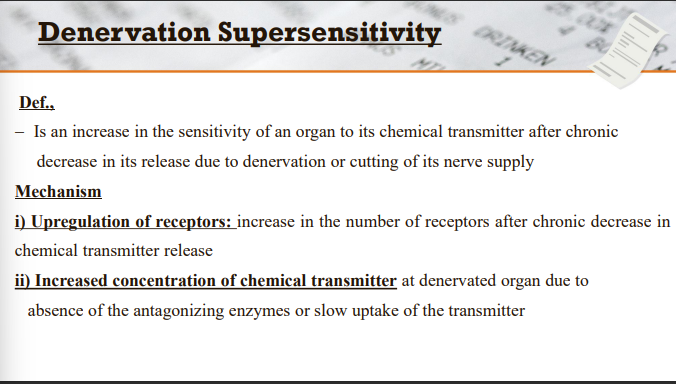Physiology NMU part 2222
1/70
There's no tags or description
Looks like no tags are added yet.
Name | Mastery | Learn | Test | Matching | Spaced |
|---|
No study sessions yet.
71 Terms
sympathetic supply to head and neck
origin ?
relay ?
functions 4 ?
Origin:
LHCs of first and second thoracic segments
Relay: Superior cervical ganglia
Functions:
1) Eye
2) Salivary Glands
3) Skin
4) Cerebral blood vessels: mild vasoconstriction(V.C.).
sympathetic on eye ? 5 things happen
مش هعرف انقص او ارتب او كدا عشان تبقي المعلومه كامله مينفعش تجزئه في الحته دي
➢ Contraction of the dilator pupillae ms leading to dilatation of pupil or mydriasis
➢ Contraction of superior tarsal ms of the upper eyelids and inferior tarsal ms of lower eyelid leading to widening of palpberal fissure.
➢ Contraction of Muller’s ms behind the eyeball leading to exophthalmos.
➢ Relaxation of the ciliary ms leading to decrease lens convexity and power and helps the eye to see far objects.
➢ Vasoconstriction (V.C.) of blood vessels of lacrimal glands and trophic secretion.
sympathetic on salivary gland ? 3 points
➢ Vasoconstriction (V.C.) of salivary gland blood vessels.
➢ Trophic secretions: little, viscous, concentrated secretion; poor in water and rich in enzymes.
➢ Contraction of myoepithelial cells surrounding salivary acini leading to squeezing of salivary secretion outside.
sympathetic on skin 3 points ?
➢ V.C or vasodilatation (V.D.) of skin blood vessels, but VC is more powerful.
➢ Hair erection due to contraction of piloerector muscle.
➢ Sweat secretion.
horner syndrome is ?
causes ?
signs on which side ?
Def:
It is a group of signs which result from interruption sympathetic to head and neck.
Causes:
➢ Lesion in T1 and T2 segments.
➢ Lesion in SCG disease or experimentally by section in cervical sympathetic chain.
Signs:
on the same side of lesion
signs of horner syndrome 5 ?
اسم فقط والديفنشن كل واحد في كارت منفصل
1-ptosis
2-miosis
3-enophthalmos
4-anhydrosis
5-vasodilatation
ptosis is ?
paralysis of superior tarsal muscle
miosis is ?
paralysis of dilator pupillae muscle
enophthalmos is ?
paralysis muller's muscle
anhydrosis is ?
absence of sweat secretion leading to dryness affected side of the face
what happens to the skin if there is horner syndrome
Vasodilatation of skin blood vessels, loss of sympathetic vasoconstrictor tone so the skin becomes red and warm.
sympathetic supply to thorax
origin ?
relay ?
affected organs ?
Origin:
- LHCs of upper 4 or 5 thoracic segments of spinal cord.
Relay:
3 cervical lateral ganglia and upper 4 thoracic ganglia
AFFECTED ORGANS ARE HEART AND LUNGS
sympathetic supply to heart do 3?
a. It increases the heart rate, force of contraction, conductivity and excitability, so increase the effectiveness of heart as a pump.
b.Coronary vessels:
i. Direct effect → vasoconstriction.
ii.Indirect effect (Powerful)→ vasodilatation
(by accumulated metabolites)
sympathetic supply to lungs leads to ?
a.Relaxation of the smooth ms of the bronchi and air
passages
i.e. bronchodilatation
a.Inhibits the secretion of the mucus in air passages.
b.Vasoconstriction of the pulmonary blood vessels.
sympathetic supply to abdomen
origin ?
relay ?
affected organs ? 8 just the name
1-GIT
2-Liver
3-Gall bladder
4-spleen
5-pancreas
6-blood vessels
7-kidneys
8-suorarenal medulla
how is GIT affected by sympathetic supply ?
(Stomach, small intestine and proximal part of large intestine):
- Relaxation of their walls and contraction of their sphincters, so it inhibits the process of digestion and delays evacuation of GIT contents.
how is liver affected by sympathetic supply ? 2
- Stimulation of glycogenolysis , so ↑ed blood glucose.
- Stimulation of fibrinogen synthesis.
how is gall bladder affected by sympathetic supply ?
- Relaxation of its wall and contraction of sphincter of Oddi, so it delays the emptying of gall ball and help retention of bile in gall bladder
how is spleen affected by sympathetic supply ?
- Contraction of smooth muscles in splenic capsule and trabeculae, so it pours about 250 ml of stored blood into the general circulation.
how is pancreas affected by sympathetic supply
- It inhibits both endocrine and exocrine pancreatic secretion.
blood vessels sympathetic supply ?
- Mixed supply (vasoconstriction and vasodilatation)
kidney sympathetic supply ?
a) Stimulation of juxta glomerular cells → ↑ed renin secretion.
b) ↓es renal blood flow.
c) ↓es urine output.
suprarenal medulla sympathetic supply
origin ?
relay ?
function ?
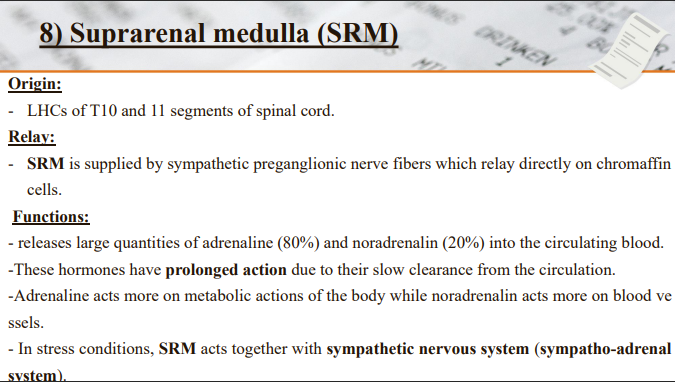
sympathetic supply to pelvis
origin ?
relay ?
3 organs
Origin:
- LHCs of L1, L2, and L3 segments of spinal cord.
Relay:
- Inferior mesenteric or hypogastric ganglia.
.
1-urinary bladder
2-rectum
3-sex organs (male or female)
effect of sympathetic supply to urinary bladder ?
- Relaxation of its wall and contraction of internal urethral sphincter → urine retention
effect of sympathetic supply to rectum
- Relaxation of its wall and contraction of internal anal sphincter→ retention of faeces
effect of sympathetic supply on male sex organ 2
a) Contraction of smooth ms in the walls of seminal vesicle, epididymis, vas deferens and
ejaculatory duct → ejaculation of semen.
b)VC of blood vessels of pelvic viscera including external sex organs → shrinkage of penis.
effect of sympathetic supply on female sex organ 2
a)VC of blood vessels of external sex organs → shrinkage of clitoris.
b) Variable effects on uterus, mainly inhibitory but may be excitatory in late pregnancy.
Sympathetic Supply to Somatic Structures origin ?
relay ?
functions ?
i) Upper limb……. LHCs of T2-9
ii) Lower limb…… LHCs of T10-L2
iii)Thoracic and abdominal walls…… LHCs of T1-L2
Relay: Corresponding sympathetic chain
Functions:
1) Skin: as in sympathetic supply to head and neck
2) Skeletal ms:
a) Vasodilatation of skeletal ms blood vessels.
b) Orbelli phenomenon:
what is orbelli phenomenon ?
- Sympathetic stimulation of skeletal ms leads to better contraction, delayed onset of fatigue, early reco
very after fatigue
- Vasodilatation →↑ed blood flow to skeletal ms which carry oxygen & glucose and remove waste pro
ducts from ms. → it is very important in muscle exercise
what is pheochromocytoma ?
what are the manifestations ? 8
how is it treated ?
سهله جدااا لو فاهمها
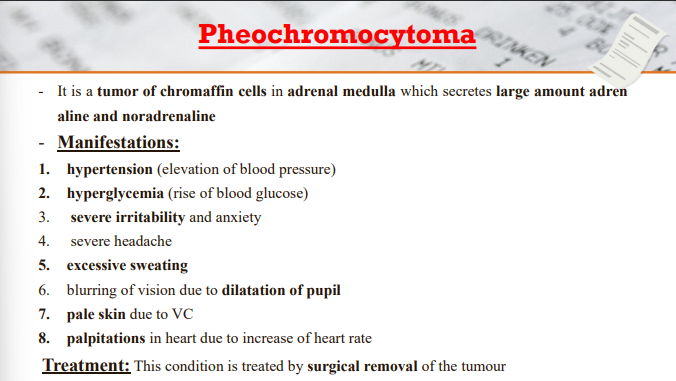
sympathetic tone (localized continous dif )
def ?
causes ?
significance ?
Def.: It is a continuous basal discharge of sympathetic impulses to the supplied
organs during rest, leading to mild activity.
Causes:
1- Continuous impulses through sympathetic nerves.
2- Continuous basal secretion of adrenaline and noradrenalin from adrenal medulla
Significance:
-Sympathetic tone constricts the blood vessels to its half diameter (partial vasocon
striction) →maintains normal arterial blood pressure.
-↑ed sympathetic activity → more vasoconstriction and more ↑ of ABP.
-Inhibition of sympathetic tone→ vasodilatation and ↓ed ABP
Sympathetic Mass Discharge (Alarm response, Fight or flight) is ?
causes ? 4
importance ? 2
Def:
It is a generalized sympathetic excitement.
Causes:
This occurs in emergency or stress conditions as:
1- Exposure to sever cold and ms exercise.
2- Pain and emotions.
3- Hemorrhage and Hypoglycemia.
4- Fear, fight and flight.
Importance:
It enables person to;
i) Face stressful situations
ii) Increase his capacity to perform vigorous muscular activity.
Sympathetic Mass Discharge (sympathetic stress response) effect name the 10 and mention the details iam sorry متنفعش غير كدا
عشان فيه كروت تانيه فوق فيها حاجات مشتركه بس بتقول ال effect هنا مختلفه سيكا
1) In the eye→ pupillary dilatations, exophthalmos and wide palpebral fissure→ ↑field of vision.
2) Heart→↑es heart rate and the force of myocardial contraction and raises the blood pressure→
provide excess bood flow to vital organs and active muscles.
3) Lungs →dilates the bronchioles to ensure better lung ventilation and more oxygen supply to
the blood.
4) Constriction of blood vessels in the skin→ limits bleeding of wounds.
5) Dilatation of blood vessels of skeletal ms and cardiac ms with VC to other areas →help in
shifting a great part of the cardiac output to the active areas.
6) Skeletal ms→ ↑es the strength of skeletal ms contraction and delays the onset of fatigue (Orb
elli Phenomenon).
7)Spleen→contraction of splenic capsule → ejection of some blood rich in red blood cells
(RBCs) into the general circulation→↑ing blood volume as well as oxygen carrying capac
ity of the blood.
8) Adrenal medulla → secretion of adrenaline and noradrenalin → potentiates the stimul
ation of sympathetic NS (sympatho-adrenal system).
9) Adrenaline;
• ↑es the blood glucose and free fatty acid level (supplying more energy).
• ↑es glycogenolysis in the liver and glycolysis in the muscle.
• ↑es mental activity and cellular metabolism throughout the body.
10) Sweat glands→↑es sweat secretion →↑es heat loss from the body by its evaporation
parasympathetic N.S. origin
(craniosacral ) :
A) Cranial part:
1.Oculomotor N. in midbrain.
2.Facial N. in pons.
3.Glossopharyngeal N. in MO.
4.Vagus nerve in MO.
B) Sacral part:
S2,S3,S4 and forms pelvic nerve
parasympathetic supply to head and neck ?
parasympathetic supply to thorax ?
parasympathetic supply to abdomin ?
parasympathetic supply to pelvis ?
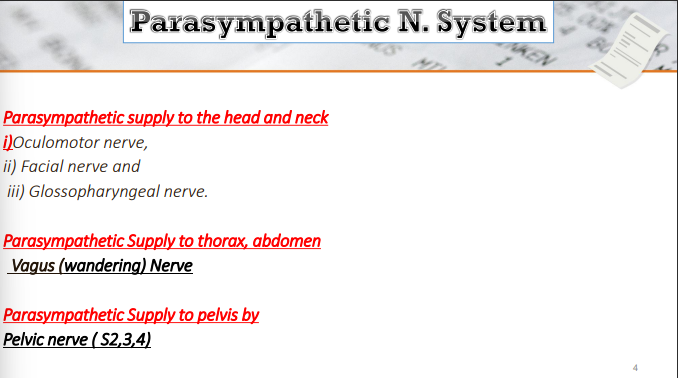
occulomotor nerve origin ?
relay ?
function ?
Origin:
Edinger Westphal nucleus in midbrain.
Relay:
Ciliary ganglion.
Functions:
1- contraction of constrictor pupillae muscle --> (miosis)
2- contraction of ciliary muscle increase convexity of
lens → helps eyes to see near objects→
accommodation to near vision
facial nerve origin ?
relay ?
origin : superior salivary nucleus in the pons
relay :
1-greater superficial petrosal branch --> sphenopalatine ganglion
2- chorda tympani branch --> submandibular ganglion
facial nerve function ?
a- Greater superficial petrosal nerve:
Lacrimal glands: Vasodilatation and secretion of tears from lacrimal glands
Mucus membrane of nose, soft palate and pharynx: Vasodilatation and secretion of
mucus.
b- Chorda tympani nerve:
Submandibular and sublingual salivary glands: Vasodilatation and true salivary secretion
(large in volume, watery, rich in electrolyte and poor in enzymes).
Mucus membrane of anterior 2/3 of tongue and floor of mouth: Vasodilatation and mucous
secretion
glossopharyngeal nerve
origin ?
relay ?
function ?
Origin:
Inferior salivary nucleus in medulla oblongata.
Relay:
Otic ganglion
Functions:
Parotid salivary gland: Vasodilatation and
True salivary secretion.
Mucus membrane of posterior 1/3 of tongue
and floor of mouth→ Vasodilatation
vagus (wandering) nerve
origin ?
relay ?
what organs does it supply ? 7
Origin: Dorsal motor nucleus of vagus in the medulla oblongata.
Relay: Terminal ganglia.
.
1- heart
2- lungs
3- GIT
4- glands (gastrec glands,pancreas)
5- liver
6-gall bladder
7-blood vessels
vagus nerve function in heart ?
1- It decreases the heart rate, force of contraction, conductivity and
excitability →decreases the effectiveness of heart as a pump.
N.B.:
Vagus nerve supplies the atria only and does not supply the ventricles (vagal
escape phenomenon)
2- Coronary vessels
Direct effect → vasodilatation.
Indirect effect → vasoconstriction because it inhibits cardiac work with less production of
metabolites.
vagus nerve function in lungs ?
1. Contraction of smooth ms of the bronchi -->bronchoconstriction
1. Stimulate the mucus secretion of the air passages.
2. Vasodilatation of the pulmonary blood vessels.
vagus nerve supply to
GIT ?
glands ?
a) GIT (esophagus, stomach, small intestine and proximal large intestine):
Contraction of their walls and relaxation of sphincters → help digestion and
evacuation of GIT contents
i.e. helps deglutition, gastric motility, and peristaltic movement.
b) Glands
1. Gastric glands→ ↑es gastric juice secretion (rich in HCL).
2. increases alkaline mucus secretion.
3. Pancreas: stimulates endocrine and exocrine components pancreatic
secretions
vagus nerve supply to ?
liver ?
gall bladder ?
blood vessels ?
1) Liver: It ↑es hepatic bile flow.
2) Gall bladder: help its evacuation.
- Contraction of its wall
- relaxation of sphincter of Oddi
3) Blood vessels:
Vasodilatation.
sacral outflow origin ?
relay ?
functions in 3 organs ? with data
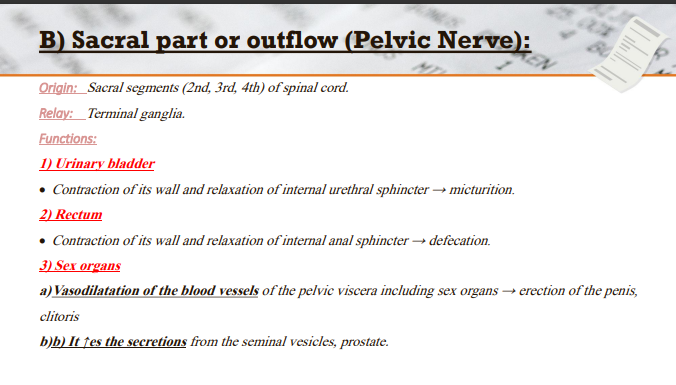
parts of the body supplied by sympathetic supply only ? 6
1)Dilator pupillae muscle
2)Muller's muscle.
3)Cutaneous effectors
4)Ventricles of heart.
5)Spleen
6)Adrenal medulla
parts of the body supplied by parasympathetic supply only ? 3
1) Constrictor pupillae muscle
2) Upper esophagus.
3) Glands of stomach
the relation between sympathetic and parasympathetic N.S may be ? 3 (with example on each)
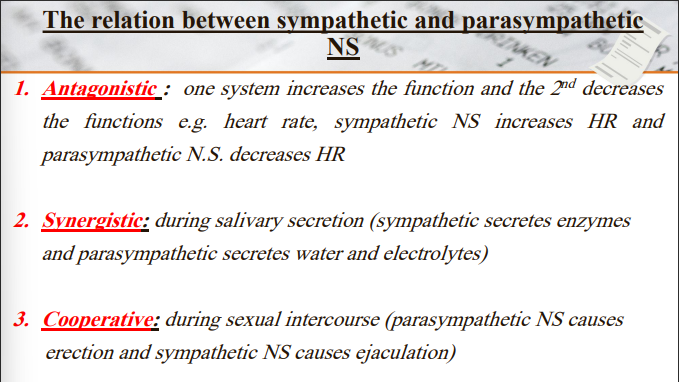
effect of autonomic nervous system on blood maybe ?
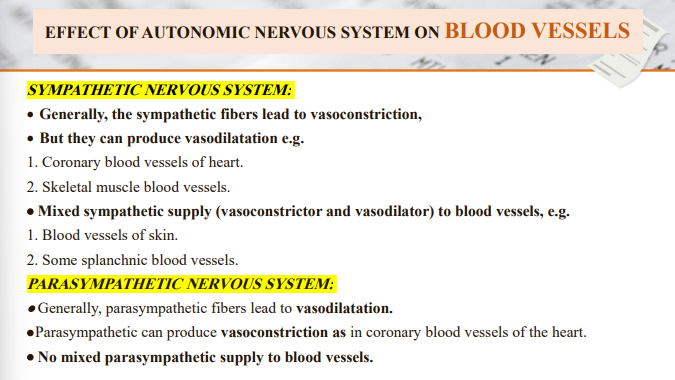
parasympathetic tone
is ?
effect ?
Def. continuous basal discharge of parasympathetic impulses to the
supplied organs during rest
Effect
i) In the heart it decreases the inherent high rhythm of SAN from 120
to 70 beat/min.
ii) in the GIT it maintains its normal motility
what is vagotomy and what does it lead to ?
what is the effect of parasympathetic mass stimulation ?
a surgical operation in which one or more branches of the vagus nerve are cut, typically to reduce the rate of gastric secretion (معلومه زياده عشان مش مكتوبه)
.
- Heart: increases its rate from 70 to 120 beat /min.
- GIT: leads to serious prolonged GIT atony.
.
- Parasympathetic mass stimulation is fatal.
sites of release of acetylcholine 6 ?
1) All preganglionic sympathetic and parasympathetic nerve endings.
2) Preganglionic sympathetic nerve fibers to suprarenal medulla.
3) All postganglionic parasympathetic nerve ending.
4) Somatic motor nerve ending to skeletal muscle (motor end plate).
5) Sympathetic postganglionic fibres supplying skeletal ms blood vessels and sweat gland.
6) Some synapses at CNS (brain and spinal cord).
how is acetylcholine formed ?
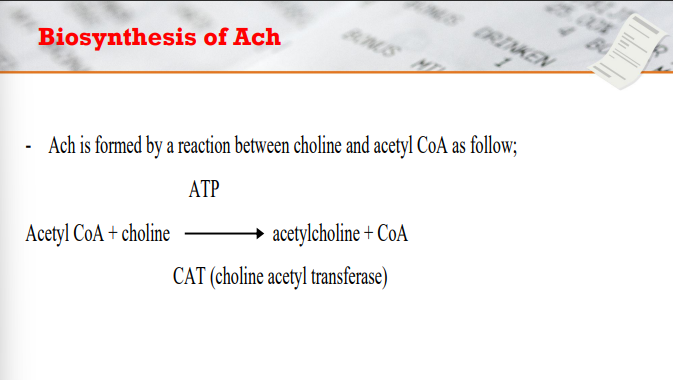
how is acetylcholine stored ? including the number if present ..
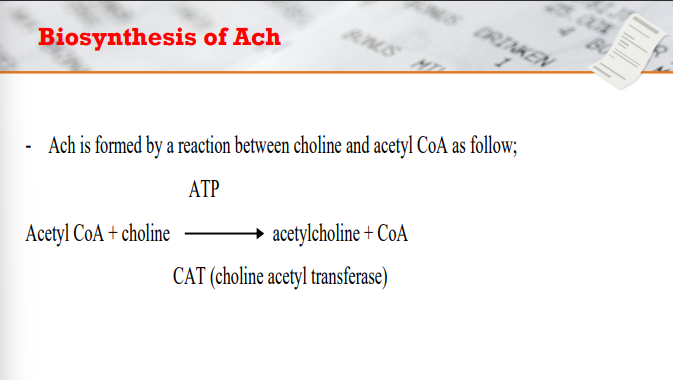
ach is released in 5 steps ?
1- Arrival of action potential (depolarization) to nerve ending
2- open Ca2+ channels →↑ed Ca2+ influx to inside nerve endings
3- interact with the vesicles adjacent to the membrane causing them to fuse with
the membrane
4- rupture of vesicles emptying their contents outside the nerve fibers by exocytosis
5- Released Ach which passes rapidly over the gap of synaptic cleft (10-30 nm) →
Ach binds to receptors on the effector organs
mechanism of action of Ach
- Ach binds with its receptors on postsynaptic membrane
which might be;
i) Ligand-gated ion channels → Na+ and Ca2+ influx → depolarization (stimulation)
or K+ efflux and Cl_ influx → hyperpolarization (inhibition).
ii) G-protein coupled receptors
how is Ach removed ?
a)Hydrolysis by cholinesterase to acetic acid and choline ( reuptake
again to form new Ach vesicle).
b) Diffusion:
-Small part of Ach escapes to the surrounding tissues→↓ed Ach
concentration.
c) Reuptake of Ach: is not a definite mechanism
whar are cholinestrases and what are its forms ?
cholinestrases is to keep the action of acetylcholine localized in the site of
liberation, so prevent its diffusion to the blood causing generalized
parasympathetic effects.
Cholinesterases has 2 forms:
(1) true (cholinergic nerve terminals) (2) pseudo (in plasma).
anticholinstrases are ?
e.g. neostigmine are drugs that block the action of
cholinesterase, so prolong the action of Ach and used to treatment of some
diseases such as myasthenia gravis
compare between muscarinic action and nicotinic action
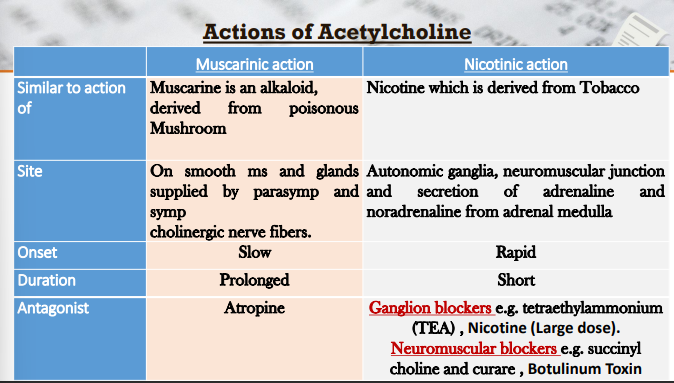
compare between muscarinic and nicotinic receptors
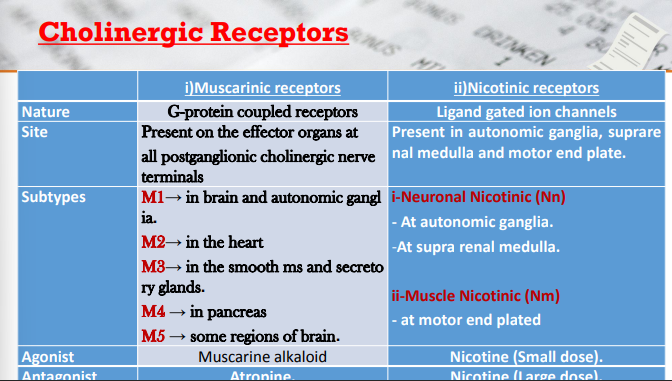
what constitute the catecholamines (adrenergic transmission)
sites of release of catecholamines ? 3
noradrenaline, adrenaline and dopamine constitute the cetacholamines
Sites of release of catecholamines:
a)All postganglionic sympathetic fibers except those supplying skin, skeletal
ms blood vessels and sweat glands.
b)Some synapses in CNS
c) Suprarenal medulla: adrenaline (80%) and noradrenaline (20%)
how are catecholamines synthesized in the axoplasm of adrenergc nerve fibers ? (dopamine formation and transmission)
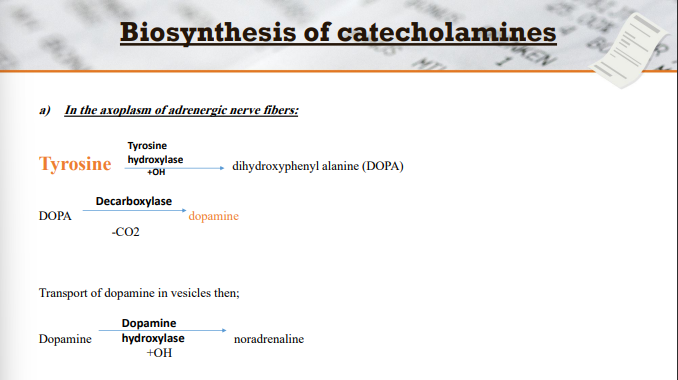
how are catecholamines synthesized in the adrenal medulla (Adrenaline biosynthesis)
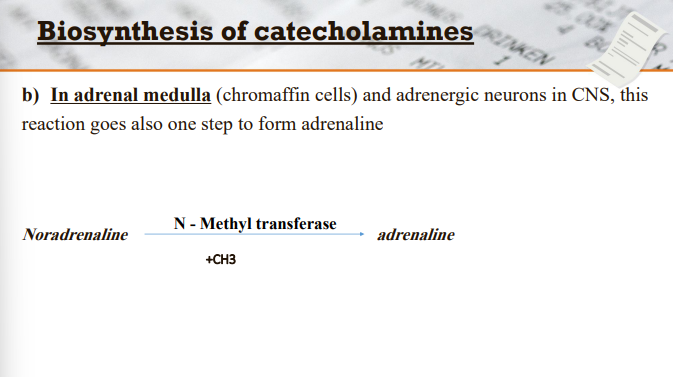
where is noradrinaline stored ?
sites of noradrenaline release ?
Noradrenaline is stored inside the nerve terminals in minute vesicles.
Sites Release Noradrenaline :
1-All Postganglionic Nerve endings (sympathetic) except Some post Ganglionic
Sympathetic To Skin , Skeletal Muscles BV , Sweat gland .
2-Suprarenal Medulla adrenaline 80% - Noradrenaline 20%
how is noradrinaline removed ?
*Neuronal uptake 85% stored in the vesicles or oxidized by mono amine oxidase (MAO).
*Extra Neuronal uptake 15% (inactivated by COMT enzyme)
*Excretion in urine
mechanism of action of noradrinaline ?

adrenergic receptors are ?
types ?
Def.,
They are the receptors which respond noradrenaline and adrenaline.
Types
i) α (Alpha) adrenergic receptors (mostly excitatory)
They include many subtypes;
α 1 receptors
α 2 receptors
ii) β (beta) adrenergic receptors (mostly inhibitory)
They are further subdivided into:
β1, β2, β3, β 4, β 5 receptors
compare between alpha 1 , 2 and beta 1,2 receptors
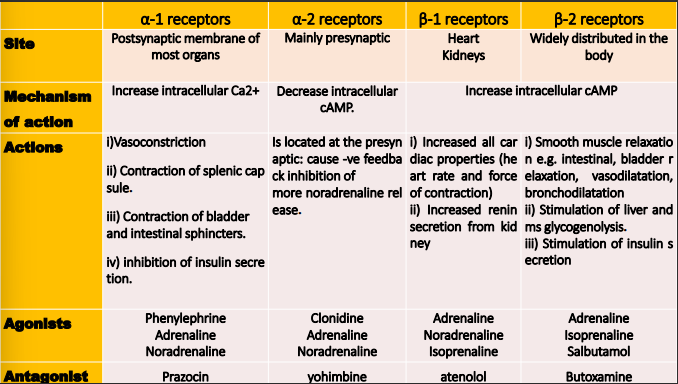
denervation supersensitivity is ? mechanism ?
